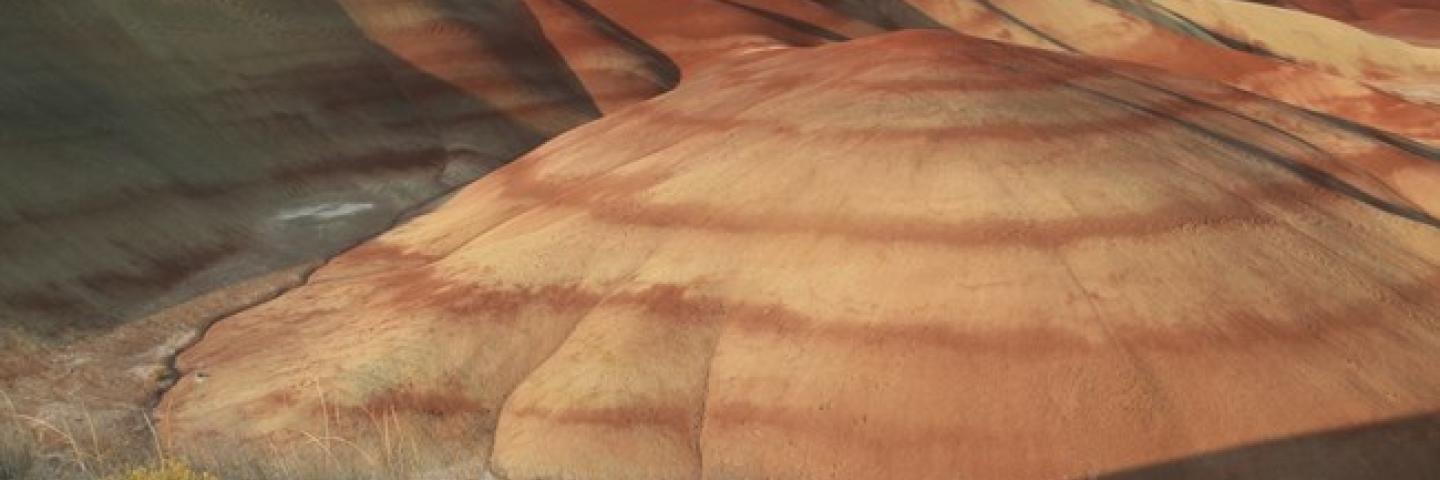New Kiosk Highlights Steelhead Conservation Success in John Day's Painted Hills

Location: John Day's Painted Hills
In January 2021, Oregon’s Natural Resources Conservation Service (NRCS) and several partners installed a new kiosk at the John Day Painted Hills National Monument. The interpretive panel is a first for NRCS Oregon, and tells the story of how private landowners and other groups voluntarily implement conservation practices that have helped restore the Bridge Creek Watershed, a natural habitat for endangered Steelhead.
Damon Brosnan, NRCS Oregon’s new Basin Team Leader for the Deschutes/High Desert Basin, worked with partners to make the interpretive panel a success.
“We do a lot of great conservation work that is beneficial to the land and the local communities, but most of the public doesn't realize that as they are driving through these landscapes,” Brosnan said.
Each year, the Painted Hills National Monument hosts more than 100,00 unique visitors traveling from near and far to see the sites and visit one of Oregon’s celebrated natural habitats. The Bridge Creek Watershed passes through the Painted Hills and connects to the John Day River, draining a total of 269 square miles and containing 69 miles of summer steelhead spawning habitat.
As one of the largest undammed rivers in the Pacific Northwest and one of two of the longest rivers west of the Mississippi, the John Day River is a key route for native populations of Steelhead and Chinook salmon migrating to and from the ocean. The river provides essential spawning and rearing habitat,
allowing young fish to mature. Conservation efforts have helped improve water quality and quantity by providing cold, fresh water from the uplands.
The new interpretive panel outlines the conservation efforts that began in 2015 when NRCS Oregon awarded a Regional Conservation Partnership Program (RCPP) project that covered the Western Waters Critical Conservation Area. Before 2015, conservation efforts were piecemeal.
Partners of the panel include private landowners, the National Parks Service’s John Day Fossil Beds National Monument, Oregon Watershed Enhancement Board (OWEB), Confederate Tribes of Warm Springs, and the Wheeler Soil and Water Conservation District (SWCD).
“I think it’s a great way to tell the story of how conservation is done by private landowners in a way that both children and adults can understand. It highlights the values that the public wants to protect,” says Brosnan.
Much of the work of today’s conservation efforts are to mitigate negative impacts that occurred 50 to 100 years ago. The Gold Rush of the late 1800s led to dredged streams, turning complex environments into canals. Streams were simplified and straightened out. Management practices such as grazing, irrigation, urban development, as well as dams on the Columbia River led to habitat degradation. Steelhead are currently endangered, with populations historically overfished.
To address the problem, efforts are two-fold: reverse negative impacts while sustaining and enhancing the remaining critical resources for the species. Native fish are catch and release.
Tribes collaborated to focus on stream development, removing barriers that previously diverted the fish. Forest health work was also conducted to help avoid catastrophic wildfires, which can severely degrade water quality.
To ensure the watershed efforts were a success, the Wheeler SWCS and OWEB matched up to 5 million dollars to aid in juniper cutting and irrigation efficiency.
Conservation success benefiting Steelhead in the watershed could not have happened without private landowner support.
“If it wasn’t for willing landowners to do this conservation voluntarily, we wouldn’t have a kiosk and wouldn’t be able to tell this story. Landowners are the linchpin of the whole thing,” Brosnan said.
The Regional Conservation Partnership Program addresses regional, landscape-scale or watershed-scale issues. Farmers, ranchers and forest owners who manage property within a current RCPP project area may be eligible for conservation assistance from NRCS and other partners. Learn more here.

